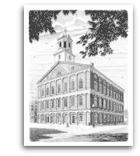Faneuil
Hall
Built in 1742 — Boston, Massachusetts
#NC-17540-MA - Notecards
Also available in Notecard Assortment #AST-1761
Merchant Peter Faneuil felt so strongly that Boston needed a central market, he built one at his own expense and donated it to the city. To counter opposition from hawkers and peddlers, he added a second-floor town hall, where his own memorial was held six years after completion of the building.
Faneuil Hall became known as America’s “Cradle of Liberty” after Samuel Adams and others gathered there to protest British taxation policies. In 1805, a redesign by renowned architect Charles Bulfinch doubled the width and height of the building while retaining its basic style. Built with money gained from the slave trade, the building hosted Frederick Douglass and other well-known abolitionists in the mid-1880s. The glass eyes of a gilded grasshopper weathervane still gaze down on visitors as they approach Faneuil Hall to shop and to attend public meetings.
Text
© 2005 Terry White, Drawing © 2005 Bill Harrah
|

|
|
Copyright
Notice
Drawings Copyright © 1992-2010 Bill Harrah, Wolf Run Studio (SM), All Rights
Reserved. Wolf Run Studio is a service mark of Bill Harrah and has been in continuous use since 1992. All of the images on this website are in tangible form and are fully
copyrighted. Each has an invisible digital identification which is traceable
through the Digimarc Corporation. Viewers of the Wolf Run Studio website are
allowed to browse and print out images for personal, non-commercial use only.
You may not distribute copies of images or image files to anyone else for any
reason. Images may not be reproduced or used in any form or any manner, or displayed
on any website without the express written consent of Bill
Harrah.
Text Copyright
© 1992-2008
Terry White or
Dianne Harrah. Text on this website is used with permission from the authors.
Viewers of the Wolf Run Studio website are allowed to browse and print out text
for personal, non-commercial use only. Text may not be reproduced or used in any
form or any manner without the express written consent of the authors.
Information
Accuracy
The information for the written description of each location has been carefully
researched by the authors and is believed to be accurate. New findings, however,
could make some information out-of-date. If you are a professional historian,
archaeologist, or architect, and have new information that you are willing to
share, please contact
Dianne Harrah
.
|



